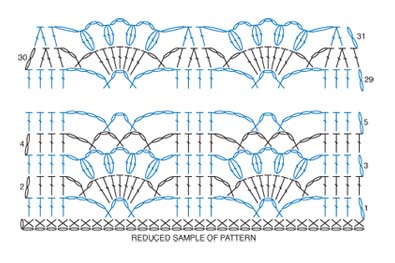Cora
 |
| Learn to Read Crochet Stitch Diagrams
This is where a stitch diagram can reduce some of the confusion of written patterns. But first you have to know how to read a stitch diagram. Stitch diagrams use a picture to represent each stitch. These stitch pictures are arranged to illustrate the order of the stitches and their relationship to one another. Stitch diagrams c Stitch along with me, using the stitch diagram for the Beach Sarong from the Summer 2009 issue of Interweave Crochet. This project uses a fairly simple stitch diagram with a repeat. A stitch diagram is usually shown from only one side, generally the right side. When working in rows, read the right side rows of the stitch diagram from right to left and the wrong side rows from left to right. This method of following stitches back and forth can take a bit of getting used to. A simple trick I use is to always mark the right side of the project to help you remember whether you need to read right to left or left to right for your current row. Once you can read stitch diagrams, you can create projects even if the directions are in a language you don’t understand. Many Japanese crochet books use Stitch diagrams are accompanied by a stitch key, but usually not instructions on how to create the stitches. I find it handy to keep a stitch reference book handy. My go-to guide is the Crocheter’s Companion, which includes stitches ranging from single crochet to motifs to Tunisian, as well as finishing techniques and troubleshooting. Particularly helpful is an international stitch symbol chart that gives the British stitch terms, which are different from U.S. stitch terms. Now, give working from stitch diagrams a whirl. Many patterns use a combination of both or provide both a stitch diagram and written instructions. Best wishes, Toni |
| Over on CrochetMe: |
| On the blog: Toni creates an ice dragon from a free pattern on CrochetMe’s pattern section. On the Forums: Find a Crochet group in your hometown or list your own. |

 Crochet is a wonderfully creative process. Because you usually have only one working loop, you can work your next stitch in several different places. Of course, this marvelous feature can make writing or following crochet patterns a challenge. Any one stitch or action can be explained ten different ways (I know because I’ve seen many of them). And crochet definitions vary by country, so a designer from France explains things differently than a designer from, say, Michigan.
Crochet is a wonderfully creative process. Because you usually have only one working loop, you can work your next stitch in several different places. Of course, this marvelous feature can make writing or following crochet patterns a challenge. Any one stitch or action can be explained ten different ways (I know because I’ve seen many of them). And crochet definitions vary by country, so a designer from France explains things differently than a designer from, say, Michigan.

No comments:
Post a Comment
If you have any questions or concerns please direct them to craftygal1965{at}gmail.com. Any other comments please leave here. Please no external links, thank you.
Thank you
Cora Shaw (formerly Levesque)